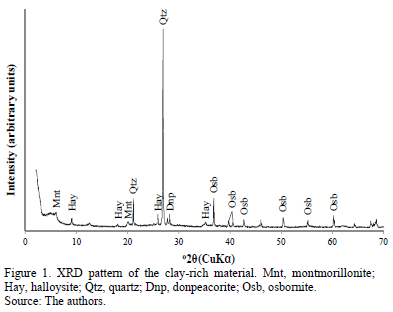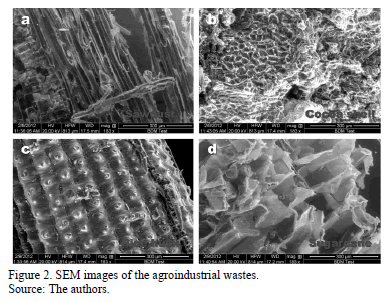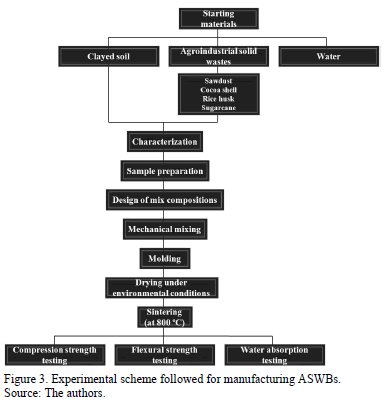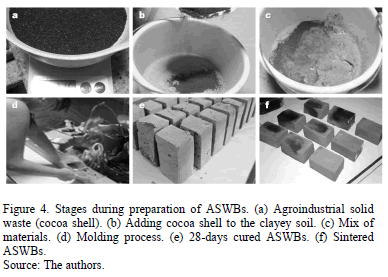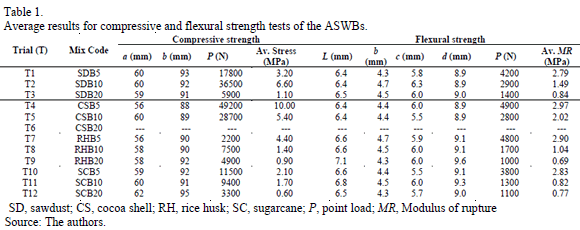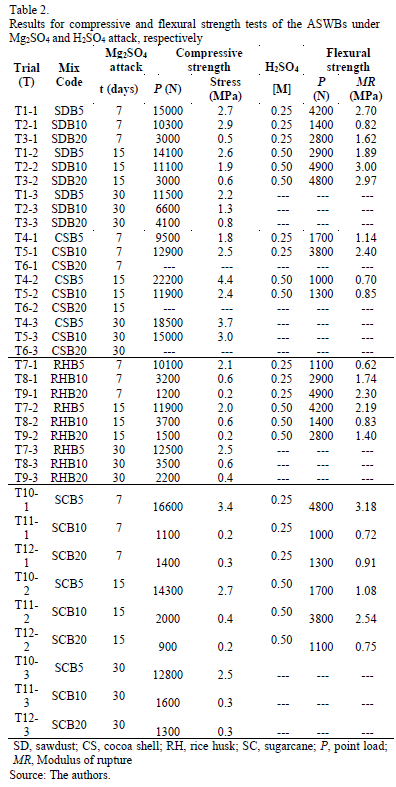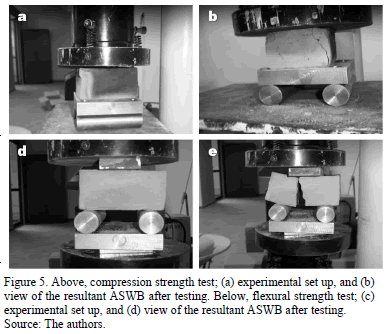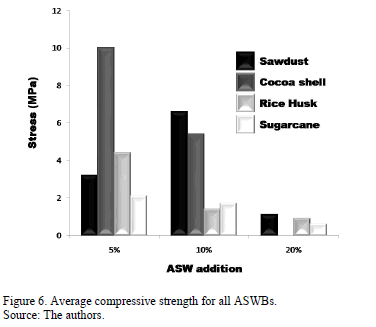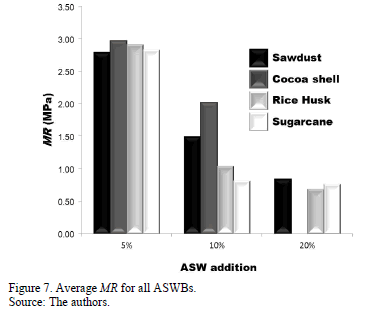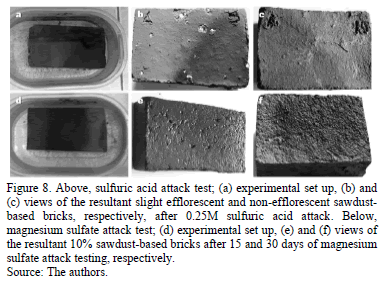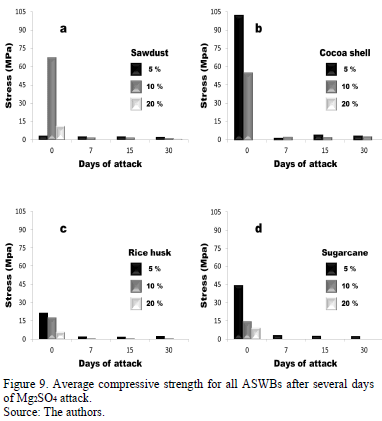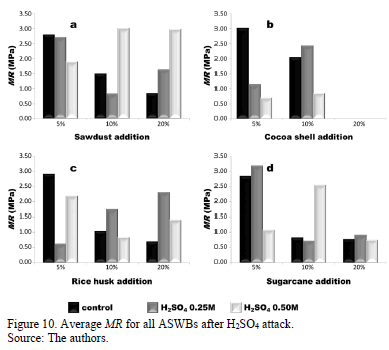Serviços Personalizados
Journal
Artigo
Indicadores
-
 Citado por SciELO
Citado por SciELO -
 Acessos
Acessos
Links relacionados
-
 Citado por Google
Citado por Google -
 Similares em
SciELO
Similares em
SciELO -
 Similares em Google
Similares em Google
Compartilhar
DYNA
versão impressa ISSN 0012-7353
Dyna rev.fac.nac.minas vol.81 no.188 Medellín nov./dez. 2014
https://doi.org/10.15446/dyna.v81n188.39717
http://dx.doi.org/10.15446/dyna.v81n188.39717
Recycling of agroindustrial solid wastes as additives in brick manufacturing for development of sustainable construction materials
Reciclaje de residuos sólidos agroindustriales como aditivos en la fabricación de ladrillos para el desarrollo sostenible de materiales de construcción
Lisset Maritza Luna-Cañas a, Carlos Alberto Ríos-Reyes b & Luz Amparo Quintero-Ortíz c
a Escuela de Geología, Universidad Industrial de Santander, Bucaramanga, Colombia, lissetluna1829@hotmail.com
b Escuela de Geología, Universidad Industrial de Santander, Bucaramanga, Colombia, carios@uis.edu.co
c Escuela de Ingeniería Metalúrgica y Ciencia de Materiales, Universidad Industrial de Santander, Bucaramanga, Colombia, luzquint@uis.edu.co
Received: August 31th, 2013. Received in revised form: March 13th, 2014. Accepted: October 25th, 2014.
Abstract
Accumulation of unmanaged agroindustrial solid wastes especially in developing countries has resulted in an increased environmental concern. Recycling of such wastes as a sustainable construction material appears to be a viable solution not only to the pollution problem but also an economical option to design green buildings. This paper studies the application of several agroindustrial wastes in brick manufacturing, which include cocoa shell, sawdust, rice husk and sugarcane. First, the mineralogical and chemical composition of the wastes and clayey soil were determined. Next, bricks were fabricated with different quantities of waste (5%, 10% and 20%). The effect of adding these wastes on the technological behavior of the brick was assessed by compressive strength, flexural strength and durability tests. Based on the results obtained, the optimum amounts of agroindustrial waste to obtain bricks were mixing 10% of cocoa shell and 90% of clayey soil. These percentages produced bricks whose mechanical properties were suitable for use as secondary raw materials in the brick production.
Keywords: agroindustrial wastes; bricks; recycling; construction material; engineering properties.
Resumen
La acumulación de residuos sólidos agroindustriales no administrados especialmente en los países en vías de desarrollo ha dado lugar a una creciente preocupación ambiental. El reciclaje de tales residuos como un material de construcción sostenible parece ser una solución viable no sólo al problema de la contaminación, sino también una opción económica para diseñar edificios verdes. El presente trabajo estudia la aplicación de varios residuos agroindustriales en la fabricación de ladrillos, que incluyen cáscara de cacao, aserrín, cáscara de arroz y caña de azúcar. En primer lugar, se determinó la composición mineralógica y química de los residuos y del suelo arcilloso. A continuación, los ladrillos se fabricaron con diferentes cantidades de residuos (5%, 10% y 20%). El efecto de la adición de estos residuos en el comportamiento tecnológico del ladrillo se evaluó mediante ensayos de resistencia a la compresión, resistencia a la flexión y durabilidad. Con base en los resultados obtenidos, las cantidades óptimas de residuos agroindustriales para obtener ladrillos fueron mezclando 10% de cáscara de cacao y 90% de suelo arcilloso. Estos porcentajes producen ladrillos cuyas propiedades mecánicas eran adecuadas para su uso como materias primas secundarias en la producción de ladrillos.
Palabras clave: residuos agroindustriales; ladrillos; reciclaje; materiales de construcción; propiedades de ingeniería.
1. Introduction
Agroindustry generates considerable quantities of solid wastes which are rich in organic matter and could constitute new materials for value added products. Because of their biodegradable nature, several agroindustrial residues can be safely disposed of; however, the amount of discharged residues is expected to increase dramatically in the future. In Colombia, they are mostly underutilized, untreated and thus in most cases disposed off by unplanned landfilling. Due to increasing landfill costs, stricter environmental regulation and current interest in sustainable development, the effective recycling of agroindustrial residues for the manufacture of bricks of greater value to mitigate the depletion of resources and environmental impact has become an increasing concern in recent years. Traditional construction materials, including bricks, are being produced from existing natural resources, which is destroying the environment due to their continuous exploration and depletion. On the other hand, large concentrations of toxic substances are emitted into the atmosphere during the manufacturing process of construction materials, which has a strong negative environmental impact. Consequently, major changes regarding the conservation of resources and recycling of wastes by proper management are taking place in our ways of living and working [1]. Many authorities and investigators are lately working to have the privilege of reusing the wastes in environmentally and economically sustainable ways [2]. Therefore to satisfy the continuously increasing demand, researchers are incorporating solid wastes for the manufacturing of novel construction materials to develop sustainable alternative solutions. From the standpoint of energy saving and conservation of natural resources, the use of alternative constituents in construction materials is now a global concern [1]. It well known that almost all the buildings comprise a structure of reinforced concrete and facade made of brick walls [3]. Attempts have been made to incorporate several industrial wastes in the manufacturing of bricks, including paper-making pulp [4-5], cigarette butts [6], steel slag [7-8], fly ash [9-10], water treatment sludge [11-12], thin film transistor liquid crystal display optical glass [13], processed tea [14], sawdust [15-16], cotton waste [17], polystyrene fabric [18], rubber [19], granite sludge [20], limestone powder waste [15,17] and waste foundry sands [21]. These studies demonstrated that the use of waste materials can save energy and enhance brick quality. The purpose of our research was to develop a comparative study on the use of several agroindustrial wastes (cocoa shell, sawdust, rice husk and sugarcane) in the manufacturing of bricks. The experimental study includes a laboratory simulation of the industrial brick-making process to assess technological feasibility, and technological trial to validate prior results.
2. Experimental procedure
2.1. Preparation of the samples
The materials used for the manufacture of agroindustrial solid waste-based bricks (ASWBs) consisted of raw clay-rich material, cocoa shell, sawdust, rice husk and sugarcane. The raw clay-rich material used in this study was supplied by ERGO Durán & García Brick Company Ltda., from the brick plant in Girón, Santander (Colombia).The clayey soil is currently used by this company to make fired bricks of different shapes and sizes with dimensional tolerances that conform to ASTM Standards. Agroindustrial solid wastes were obtained from the supply and storage center (Centroabastos), Santander (Colombia). Their use should be promoted as an appropriate and alternative low cost but high quality building technology. Calculated amounts of cocoa shell, sawdust, rice husk and sugarcane were added to the
clayey soil and mixed in a mortar to obtain good homogenization. To enable comparative results, three samples per series were prepared for the tests. The necessary amount of water was added to the samples to obtain adequate plasticity and absence of defects, mainly cracks, during the semi-dry molding stage, using a mold of 50 x 60 x 90 mm. Agroindustrial solid waste-free mixtures were also prepared as a control. Therefore, ASWBs with a cross section of 50x 60 mm and a length of 90 mm were obtained. Samples were fired in a laboratory furnace at 800 oC for 4 h. Samples were then cooled to room temperature by natural convection inside the furnace. The shaped samples were designated as C (control) for the bricks without agroindustrial solid waste and ASWxB for the mixtures, where ASW and x denotes the type of residue incorporated (CS - cocoa shell; SD - sawdust; RH - rice husk, and SC - sugarcane) and its content (%) in the clay matrix, respectively.
2.2. Properties of materials
Qualitative determination of major crystalline phases present in the clay-rich material was achieved by using a powder X-ray diffractometer (PhilipsPW1710), operating in Bragg-Brentano geometry with Cu K a radiation (k = 1.5406 Å), 40 kV and 40 mA, and secondary monochromation. Data was collectedin the 2-70º 2q range (0.02º step size). The crystalline patterns were compared with the standard line patterns from the Powder Diffraction File database supplied by the International Centre for Diffraction Data (ICDD), with the help of the Joint Committee on Powder Diffraction Standards (JCPDS) files for inorganic compounds. The major crystalline phases found in the clay-rich material are quartz, montmorillonite, halloysite, donpeacorite and osbornite (Fig. 1).
The morphology of the agroindustrial wastes (Fig. 2) was examined by environmental scanning electron microscopy (ESEM) (FEI Quanta 650), under the following analytical conditions: magnification = 183x, WD = 17.2-17.5, HV = 20.0 kV, spot = 3.0, mode SE, detector LFD.
The particle size distribution of the clay-rich material was obtained by Niño et al. [22], combining sieve and hydrometer analyses according to the standards ASTM C136-06 [23] and ASTM D1140-00[24], revealing that it is mainly composed of sand particles (87.80%), with 13.63% of fine particles and 1.57% of gravel particles, corresponding to a sandy clay soil. Niño et al. [22] also reported the Atterberg's limits of the clay-rich material according to the standard ASTM D4318-10 [25], with the following results: liquid limit of 35%, plastic limit of 17% and plasticity index of 18%.
2.3. Sample preparation, mix compositions and testing
Fig. 3 illustrates a block diagram showing the methodology followed in the manufacturing of the ASWBs during their study. The raw clay-rich material was naturally dried during 3 weeks under the following environmental conditions: average temperature of 24 oC and relative humidity of 83.5%. Then, it was subjected to the following steps: rough crushing with a Retsch Jaw Crusher BB200 to ~2 mm, milling with a Retsch RM100 mortar grinder mill to clay particle size and sieving with a 200 mesh Ro-Tap sieve shaker (using 4, 10, 20, 40, 60, 100 and 200 mesh series). The agroindustrial residues were dried for 24 hours under the direct sunlight to remove the excess moisture. Then, they were cut in fragments of different average dimensions. In order to determine the effect of the addition of agroindustrial residues on the engineering properties of ASWBs. Different amounts of ASWBs (5%, 10% and 20%) were chosen for the mix design of the ASWBs. The mix proportions were prepared based on the dry weights of the ingredients. The quantities of the dry materials obtained from the mix design were measured in each case with the aid of a weighing balance. First, the dry materials were mixed by hand with a spade on a hard surface until they reached a uniform color. Then, water was added and mixing continued until a homogeneous mixture was obtained. The resultant mixtures were compacted manually in appropriate molds using predetermined masses corresponding to the maximum density (found from standard compaction tests).
The units of ASWBs were manufactured with cuboidal shape and standard size (60 x 50 x 90 mm). The specimens were dried at 100 oC for 24 hours, removed from the molds and were fired in a (TERRIGENO) furnace at 800 oC. The fired samples were tested for compressive strength, flexural strength, and Mg2SO4 and H2SO4 attack. All tests were carried out according to ASTM standards and the results reported are the mean of three values.
Fig. 4 illustrates the preparation of the ASWBs. In order to obtain comparable results, a total of 12 ASWBs (3 for each mixture) were prepared for testing four different series. The shape and size tolerances have been respected. ASWBs were cured for 28 days under the following environmental conditions: average temperature of 25 oC and relative humidity of 80%. Too much clay will cause cracks in the blocks while too much sand will cause the blocks to crumble. The suitable soil must contain the right proportions of sand, silt, clay and water.
The swelling/shrinkage behavior of the 28-days cured ASWBs was determined as follows. Immediately after the fabrication of the ASWBs, their dimensions were recorded and at the end of the 28-day curing period, a record of their dimensions was also taken. There was no significant dimensional or volume increase in any of the ASWBs. No defects such as cracks and bloating were observed after firing. However, a texture characterized by black cores are developed after firing, which can be attributed to organic matter that is not completely burned during firing [26-27]. In general, the color of the fired samples was reddish, which is similar to that observed in the formulas without wastes, although somewhat lighter as the proportion of waste increases. Engineering tests were conducted in a computerized device for mechanical assays according to the ASTM C67-11 standard [28]. A Universal Testing Machine (MTS 810) with a maximum load of 500000 N was used in the testing procedure, taking into account its accuracy (0.01), flexibility, high performance, and innovative standard features; large test space to accommodate standard, medium and large size specimens, grips, fixtures and environmental subsystem, and environmental chamber dimension: 500 x 255 x 350 mm. Data were recorded automatically to the computer system which the user can manipulate the collected results. The compressive strength test was conducted with a crosshead speed of 0.5 mm/min. This test was performed according to ASTM D 2166-00e1 [29]. The test was carried out as follows: ASWBs were placed between two steel bearing plates (on the top and on the bottom), which were identical (length, width and thickness were respectively 100 x 40 x 5 mm). The load strain reading at failure was recorded; it was the maximum load the specimen could carry in compression. The three-point bending flexural strength test was conducted with a cross head speed of 0.2 mm/s and a distance between the supports of 90 mm. This test was performed according to ASTM D 1635-00 [30]. The procedure performed on the ASWBs was as follows: two cylindrical steel rollers (length of 100 mm and diameter of 5 mm) were set at a distance of 99-129 mm apart on the bottom steel support plate (length, width and thickness were respectively100 x 40 x 5 mm). The ASWBs were placed over the bottom steel support plate, which reduced the frictional forces between the rollers and the ASWBs. A loading steel roller identical to the two described above was set on top of the ASWBs. The load was applied via a steel roller, identical to those described above, directly onto the ASWBs. The maximum load until the occurrence of the first crack was recorded as flexural strength. Upon crack occurrence, the strength decreased. This test provides values for the modulus of rupture (MR) of the ASWBs. MR can be calculated according to Varela et al. [31] using Eq. (1).

Where MR is the flexural modulus of rupture (MPa), P is the maximum applied load (N), a is the distance between line of fracture and the nearest support (mm), b and d are the width and thickness of the specimen (mm), respectively. The total water absorption capacity of the ASWBs established by the water absorption (WA) test. After 28 days of curing time, the dry specimens were weighed. Then, they were subjected to 24 h submersion. The water of absorption can be determined from the moist weight of specimens after submersion according to the standard ASTM C67-11 [28].
3. Results and discussion
Some of the physical and chemical properties of the ASWBs are presented in Tables 1-2. The ASWBs containing residues expanded slightly when fired at 800oC, resulting in a typical behavior of porous bodies. This may be due to the high content in quartz of the clay that is inert at the studied temperature which reduces the contraction of the piece, as well as to the increase in porosity due to the high content in organic matter in the organic residues. All ASWBs showed a contraction at this temperature. The weight loss experienced by the samples upon temperature increased with respect to the residue content at 800 oC for all types of wastes. This weight loss could be due to the elimination of the organic matter from the clay and residue by means of combustion and to the elimination of water content from clay mineral due to dehydroxylation reactions in the clay as suggested by Eliche-Quesada et al. [32].
According to Romero et al. [33], it is apparent that open porosity in the ASWBs decreases when the amount of liquid phase tends to approach the particles. The temperature decreased the porosity of the ASWBs. The changes in this property were notable with the addition of sawdust, while the addition of cocoa shell, rice husk and sugarcane produced minor differences in apparent porosity similar to results obtained by Eliche-Quesada et al. [32]. The addition of agroindustrial wastes increased the porosity of the ASWBs, however this effect is expected, since the organic matter of the wastes were eliminated during the thermal process, leading to an increase in the open porosity of the ceramic bodies. Water absorption, firing temperature and type and content of the residue affects the quality of the final material and its durability significantly [32]. According to Niño et al. [22], the clayey soil showed an average water absorption of 30.21%. The addition of waste should produce a significant increase in water absorption. However, the combustion of organic matter acted differently in the formation of interconnected surface porosity [32].
Fig. 5 illustrates the compressive strength and flexion strength test and set up.
The typical load and compressive strength test is shown in Fig. 5a-5b. The average compressive strength of the ASWBs as a function of waste content is presented in Fig. 6 and results are depicted in Table 1.
Fig. 6 shows that the compressive strength tends to decrease with the waste addition except for sawdust-based bricks, which can be related to the higher apparent porosity than clay bricks without residues. The results were better for cocoa shell, with a higher compressive strength using 5 wt.% of cocoa shell, which can be explained by the presence of oil in the waste as suggested by Eliche-Quesada et al. [32], oily films form between particles, acting as lubricants during formation of the clay body and permitting more efficient packing. This phenomenon would promote an increase in mechanical properties of ASWBs. However, a greater percentage of cocoa shell (10 and 20 wt.%) may generate oil pockets that result in pores after firing and contribute to a decrease in compressive strength as reported by Monteiro and Vieira [34]. Nevertheless, in all ASWBs, including those with higher percentages of waste addition, compressive strengths are always less than the minimum amount (10 MPa) required by existing regulations, except for the 5 wt.% of cocoa shell-based bricks, which produced compressive strength values around 10 MPa.
The typical load and deflection in the beam-flexural test is shown in Fig. 5c-5d and results are depicted in Table 1. The average MR of the ASWBs as a function of waste content is presented in Fig. 7 and results are depicted in Table 1.
Fig. 8 illustrates the experimental set up for ASWBs under Mg2SO4 and H2SO4 attack.
Figs. 9-10 illustrate the average compressive strength and MR for all ASWBs attacked by Mg2SO4 and H2SO4, respectively, and results are depicted in Table 2.
Fig. 9 shows the average compressive strength of ASWBs with different percentages and type of agroindustrial wastes before and after Mg2SO4 attack. As can be seen, ASWBs shows a strong decrease in the compressive strength after Mg2SO4 attack, with residual values that decreased with days of attack, although with cocoa shell-based bricks kept slightly higher compressive strength values compared with the rest of the ASWBs, and the highest compressive strength values after 15 days of Mg2SO4 attack. However, data from 20 wt.% of cocoa shell addition were not reported.
Fig. 10 shows the average MR of the ASWBs with different percentages and type of agroindustrial wastes before and after H2SO4 attack. As can be seen, ASWBs (5 wt.% addition) show lower MRs than bricks made solely with the clayey soil, except for sugarcane-based bricks, which showed higher MR values after H2SO4 0.25M attack. On the other hand, the MR decreased with increasing H2SO4 concentration, except for rice husk-based bricks. With 10 wt.% of waste addition, at low H2SO4 concentration, the MR decreased for sawdust- and sugarcane-based bricks, and increased for cocoa shell- and rice husk-based bricks. These results were also obtained at high H2SO4 concentration. However, with increasing H2SO4 concentration, the MR decreased for cocoa shell- and rice husk-based bricks and
increased for sawdust- and sugarcane-based bricks. With 20 wt.% of waste addition, at low H2SO4 concentration, the MR increased for all ASWBs, except for cocoa shell-based bricks (data not reported). These results were also obtained at high H2SO4 concentration. However, with increasing H2SO4 concentration, the MR decreased for all ASWBs, except for sawdust-based bricks. For cocoa shell-based bricks, data were not reported.
After performing durability and strength tests on the ASWBs, results show that most of them perform below the acceptable level in all tests, except for the cocoa shell-based bricks.
4. Conclusions
During different agroindustrial activities, huge quantity of solid wastes can be generated as by-products, which pose major environmental problems as well as occupy a large area of land for their storage/disposal. There is a tremendous scope for setting up secondary industries for recycling and using such huge quantities of solid wastes such as minerals or resources in the production of construction materials. Environment-friendly, energy-efficient, and cost-effective alternative materials produced from solid wastes will show a good market potential to fulfill people's needs in rural and urban areas. This study shows that viable bricks can be manufactured with the addition of different percentages of agroindustrial wastes to the traditional clay mix. At the temperature investigated, changes occurred in the values of the bulk density, water absorption and apparent porosity with waste addition, which in turn caused changes in the porosity. Apparent porosity and water absorption values increased with the addition of residues. During the sintering process, the development of a liquid phase caused a decrease in open porosity and water absorption. This increased the compressive strength by reducing the porosity content. Because water absorption is related to the durability of bricks and because the compressive strength of ceramic materials is the most relevant engineering quality index for building, the cocoa shell-based bricks obtained at 800 oC had the best quality. The results indicated that is possible to obtain ASWBs mixing 10% of cocoa shell and 90% of clayey soil, which fulfill the technological standards for traditional bricks and possess mechanical properties similar to those of clay bricks without this waste. Use of these residues could have practical implications as a means of recycling and for achieving cost savings in brick production, since fewer raw materials would be required.
Acknowledgments
This research forms part of the L.M. Luna's undergraduate thesis from the Universidad Industrial de Santander. We gratefully acknowledge the Universidad Industrial de Santander for the use of research facilities (X-ray diffraction and Microscopy laboratories) and human resources; with special thanks to Luis Garrido from the Laboratory of Crushing, Milling and Grinding of the School of Geology (Universidad Industrial de Santander). The authors also thank the ERGO Durán & García Brick Company Ltda. for providing facilities to study the mining area and to Ing. Luz Torrado and Vicente Paez from the Concrete and Strength of Materials Laboratory of the Civil Engineering Program (Universidad Pontificia Bolivariana) for their assistance with experimental tests. The authors also acknowledge the anonymous referees for their critical and insightful reading of the manuscript and are most grateful to the above-named people and institutions for support.
References
[1] Safiuddin, Md., Jumaat. M.Z., Salam, M.A., Islam, M.S. and Hashim, R., Utilization of solid wastes in construction materials. International Journal of Physics Sciences, 5 (13), pp. 1952-1963, 2010. [ Links ]
[2] Aubert, J.E., Husson, B. and Sarramone, N., Utilization of municipal solid waste incineration (MSWI) fly ash in blended cement: Part 1: Processing and characterization of MSWI fly ash. Journal of Hazardous Materials, 136, pp. 624-631, 2006. http://dx.doi.org/10.1016/j.jhazmat.2005.12.041 [ Links ]
[3] Martínez-Lage, I., Vázquez-Herrero, C., González-Fonteboa, B. and Martínez-Abella, F., Generation of recycled aggregates and technical requiremetns for some applications. DYNA, 77 (161), pp. 89-97, 2010. [ Links ]
[4] Maschio, S., Furlani, E., Tonello, G., Faraone, N., Aneggi, E., Minichelli, D., Fedrizzi, L., Bacchiorrini, A. and Bruckner, S., Fast firing of tiles containing paper mill sludge, glass cullet and clay. Waste Management, 29, pp. 2880-2885, 2009. http://dx.doi.org/10.1016/j.wasman.2009.06.016 [ Links ]
[5] Mucahit, S. and Sedat, A., The use of recycled paper processing residue in making porous brick with reduced thermal conductivity. Ceramics International, 35, pp. 2625-2631, 2009. http://dx.doi.org/10.1016/j.ceramint.2009.02.027 [ Links ]
[6] Aeslina, A.K., Abbas, M., Felicity, R. and John, B., Density, strength, thermal conductivity and leachate characteristics of light weight fired clay bricks incorporating cigarette butts. International Journal of Environmental Science and Engineering, 2 (4), pp. 179-184, 2010. [ Links ]
[7] Shih, P., Wu, Z. and Chiang, H., Characteristics of bricks made from waste steel slag. Waste Management, 24, pp. 1043-1047, 2004. http://dx.doi.org/10.1016/j.wasman.2004.08.006 [ Links ]
[8] El-Mahllawy, M.S., Characteristics of acid resisting bricks made from quarry residues and waste steel slag. Construction and Building Materials, 22, pp. 1887-1896, 2008. http://dx.doi.org/10.1016/j.conbuildmat.2007.04.007 [ Links ]
[9] Sarkar, R., Singh, N. and Das, S.K., Effect of addition of pond ash and fly ash on properties of ash-clay burnt bricks. Waste Management Research, 25, pp. 566-571, 2007. http://dx.doi.org/10.1177/0734242X07080114 [ Links ]
[10] Cultrone, G. and Sebastián, E., Fly ash addition in clayey materials to improve the quality of solid bricks. Construction and Building Materials, 23, pp. 1178-1184, 2009. http://dx.doi.org/10.1016/j.conbuildmat.2008.07.001 [ Links ]
[11] Monteiro, S.N., Alexandre, J., Margem, J.I., Sánchez, R. and Vieira, C.M.F., Incorporation of sludge waste from water treatment plant into red ceramic. Construction and Building Materials, 22, pp. 1281-1287, 2008. http://dx.doi.org/10.1016/j.conbuildmat.2007.01.013 [ Links ]
[12] Chiang, K-Y., Chou, P-H., Hua, C-R., Chien, K-L. and Chesseman, C., Lightweight-bricks manufactured from water treatment sludge and rice husks. Journal of Hazardous Materials, 171, pp. 76-82, 2009. http://dx.doi.org/10.1016/j.jhazmat.2009.05.144 [ Links ]
[13] Dondi, M., Guarini, G., Raimondo, M. and Zanelli, C., Recycling PC and TV waste glass in clay bricks and roof tiles. Waste Management, 29, pp. 1945-1951, 2009. http://dx.doi.org/10.1016/j.wasman.2008.12.003 [ Links ]
[14] Demir, I., An investigation on the production of construction brick with processed waste tea. Building and Environment, 41, pp. 1274-1278, 2006. http://dx.doi.org/10.1016/j.buildenv.2005.05.004 [ Links ]
[15] Turgut, P. and Halil, M.A., Limestone dust and wood sawdust as brick material, Building and Environment, 42, pp. 3399-3403, 2007. http://dx.doi.org/10.1016/j.buildenv.2006.08.012 [ Links ]
[16] Demir, I., Effect of organic residues addition on the technological properties of clay bricks, Waste Management, 28, pp. 622-627, 2008. http://dx.doi.org/10.1016/j.wasman.2007.03.019 [ Links ]
[17] Halil, M.A. and Turgut, P., Cotton and limestone powder waste as brick material, Construction and Building Materials, 22, pp. 1074-1080, 2008. http://dx.doi.org/10.1016/j.conbuildmat.2007.03.006 [ Links ]
[18] Sohrab, V. and Ali, A.Y., The use of polystyrene in lightweight brick production. Iranian Polymer Journal, 12 (4), pp. 323-329, 2003. [ Links ]
[19] Turgut, P. and Bulent, Y., Physico-mechanical and thermal performances of newly develop rubber-added bricks, Energy and Buildings, 40, pp. 679-688, 2008. http://dx.doi.org/10.1016/j.enbuild.2007.05.002 [ Links ]
[20] Torres, P., Fernandes, H.R., Olhero, S. and Ferreira, J.M.F., Incorporation of wastes from granite rock cutting and polishing industries to produce roof tiles. Journal of European Ceramic Society, 29, pp. 23-30, 2009. http://dx.doi.org/10.1016/j.jeurceramsoc.2008.05.045 [ Links ]
[21] Alonso-Santurde, R., Andrés, A., Viguri, J.R., Raimondo, M., Guarini, G., Zanelli, C. and Dondi, M., Technological behaviour and recycling potential of spent foundry sands in clay bricks. Journal of Environmental Management, 92 (3), pp. 994-1002, 2011. http://dx.doi.org/10.1016/j.jenvman.2010.11.004 [ Links ]
[22] Niño, M.C., Spinosi, V. and Ríos, C.A. and Sandoval, R., Effect of the addition of coal-ash and cassava peels on the engineering properties of compressed earth blocks. Construction and Building Materials, 36, pp. 276-286, 2012. http://dx.doi.org/10.1016/j.conbuildmat.2012.04.056 [ Links ]
[23] ASTM C136-06, Standard test method for sieve analysis of fine and coarse aggregates. American Society for Testing and Materials, West Conshohocken, Pennsylvania, PA 19428, USA; 2006. [ Links ]
[24] ASTM D1140-00, Standard test methods for amount of material in soils finer than No. 200 (75-mm) sieve. American Society for Testing and Materials, West Conshohocken, Pennsylvania, PA 19428, USA; 2006. [ Links ]
[25] ASTM D4318-10, Standard test methods for liquid limit, plastic limit, and plasticity index of soils. American Society for Testing and Materials, West Conshohocken, Pennsylvania, PA 19428, USA; 2010. [ Links ]
[26] De la Casa, J.A., Lorite, M., Jiménez, J. and Castro, E., Valorisation of wastewater from two-phase olive oil extraction in fired clay, Journal of Hazardous Materials, 169, pp. 271-278, 2009. http://dx.doi.org/10.1016/j.jhazmat.2009.03.095 [ Links ]
[27] Kadir, A.A. and Sarani. N.A., An Overview of wastes recycling in fired clay bricks. International Journal of Integrated Engineering, 4 (2), pp. 53-69, 2012. [ Links ]
[28] ASTM C67-11, Standard test methods for sampling and testing brick and structural clay tile. American Society for Testing and Materials, West Conshohocken, Pennsylvania, PA 19428, USA; 2011. [ Links ]
[29] ASTM D 2166-00e1, Standard Test method for unconfined compressive strength of cohesive soils. American Society for Testing and Materials, West Conshohocken, Pennsylvania, PA 19428, USA; 2004. [ Links ]
[30] ASTM D 1635-00, Standard test method for flexural strength of soil-cement using simple beam with 3rd point loading. American Society for Testing and Materials, West Conshohocken, Pennsylvania, PA 19428, USA; 2006. [ Links ]
[31] Varela, P.G., Cotella, N.G., Oviedo, O.E., Radevich, O.A. y Kohl, R.G., Influencia de la velocidad de ensayo sobre el módulo de ruptura en moldes para fundición de precisión. Jornadas SAM 2000 - IV Coloquio Latinoamericano de Fractura y Fatiga, Neuquén, Argentina, pp. 101-107, 2000. [ Links ]
[32] Eliche-Quesada, D., Corpas-Iglesias, F.A., Pérez-Villarejo, L. and Iglesias-Godino, F.J., Recycling of sawdust, spent earth from oil filtration, compost and marble residues for brick manufacturing. Construction and Building Materials, 34, pp. 275-284, 2012. http://dx.doi.org/10.1016/j.conbuildmat.2012.02.079 [ Links ]
[33] Romero, M., Andrés, A., Alonso, R., Viguri, J. and Rincón, J.M., Sintering behavior of ceramic bodies from contaminated marine sediments. Ceramics International, 34, pp. 1917-1924, 2008. http://dx.doi.org/10.1016/j.ceramint.2007.07.002 [ Links ]
[34] Monteiro, S.N. and Vieira, C.M.F., Effect of oily waste addition to clay ceramic. Ceramics International, 31, pp. 353-358, 2005. http://dx.doi.org/10.1016/j.ceramint.2004.05.002 [ Links ]
[35] Masonry Standards Joint Committee (MSJC). Building Code Requirements for Masonry Structures. ACI 530-08/ASCE 5-08/TMS 402-08, ACI, Farmington Hills, Mich.; ASCE, Reston, Va.; TMS, Boulder, Colorado, 2008. [ Links ]
L. M. Luna-Cañas, received a BSc in Geology in 2012 from the Universidad Industrial de Santander, Bucaramanga, Colombia. She has worked as Assistant Officer in Ingeniería de Corrosión ICL in 2013, consulting for diagnosis, design and geotechnical monitoring, as a Geologist in ConstruSuelos Colombia S.A.S. in 2013, conducting geological exploration of surface and geomorphic units, and is a Junior Geologist since 2011 in AUX Colombia, applying geotechnical logging in the core description in situ and logging area.
C.A. Ríos-Reyes, received a BSc in Geology in 1989 and the Post-graduate Diploma in University Teaching in 1995 from the Universidad Industrial de Santander, Bucaramanga, Colombia. The Shimane University, Matsue, Japón, conferred him the degree of MSc in Geology in 1999. The University of Wolverhampton, Wolverhampton, England, conferred him the degree of PhD in Applied Sciences in 2008. He has been working as a full-time Lecturer of the School of Geology since 1992, where he developed his professional experience at a University teaching level during the last 22 years in the field of Mineralogy and fieldwork on crystalline basement complexes in different areas of Colombia. During the last 6 years he has focused his research interests on the use of low-cost raw materials with potential application in the mitigation of environmental problems. Actually, he is the director of the Research Group in Basic and Applied Geology at the School of Geology of the Universidad Industrial de Santander, Colombia and the director of the Microscopy Laboratory of the Guatiguará Technological Park.
L.A. Quintero-Ortíz, received a Bs Eng in Metallurgic Engineering in 1983, a Post-graduate Diploma in University Teaching in 2002, and an MSc degree in Metallurgic and Material Science Engineering in 2002, from the Universidad Industrial de Santander, Bucaramanga, Colombia. She has been working as a full-time Lecturer at the School of Metallurgic and Material Science Engineering since 1983, when she received her professional degree. Actually, she is the director of the Research Group in the Development and Technology of New Materials at the School of Metallurgic and Material Science Engineering of the Universidad Industrial de Santander, Colombia. Her research interests include of the improvement of the manufacturing, characterization and evaluation processes of materials, training human resources to boost the development of new materials, and developing materials for technological applications. Her main interests are developing materials for technological applications, improving and innovating the process of obtaining materials via casting and performing basic research on materials.













